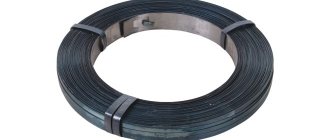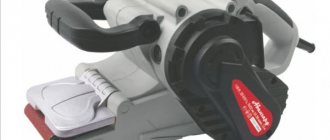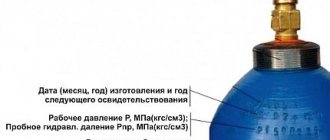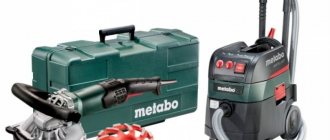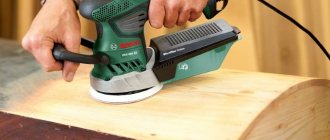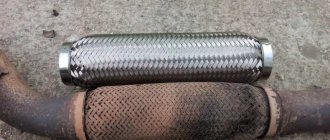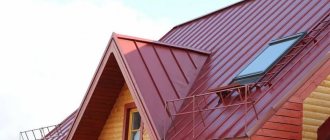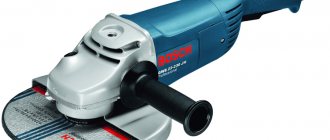Do-it-yourself grinder: drawings with dimensions and instructions for assembling a grinding machine
Large and small industrial enterprises have always had a need to have various types of grinding machines, including belt grinders, in their equipment fleet. In recent years, in connection with the development of small businesses, handicraft workshops, and simply for performing minor work on grinding any parts, desktop small-sized belt-type grinding machines began to be produced. The thing is necessary, of course, but everything is spoiled by one nuance: the high cost. And this applies not only to foreign models; prices for domestic analogues also bite sharply. Here, inevitably, many craftsmen begin to think about how to make a tape grinder with their own hands.
How does the grinder work?
A benchtop belt grinder, or simply a belt grinder, is a drive device where an electric motor plays the role of a power unit. The tool is intended for processing, finishing and grinding flat surfaces, removing the layer of rust or paint coating present on the workpieces. It is used to process burrs and sharp edges of steel, cast iron, aluminum or non-metallic parts.
Design
There is nothing particularly complicated in the design of a belt grinder. The device consists of a motor, drive and guide rollers. A sanding or roughing belt of the required grain size is passed through them.
When the engine is turned on, the drive roller mounted on its shaft begins to rotate, and through the tensioned working belt, the rotation is transmitted to the guide rollers. By pressing the part to be processed in the working area against the belt, the operator performs the required operation, changing the position of the workpiece relative to the surface of the belt if necessary.
By adjusting the distance between the guide rollers, it is possible to process surfaces with defects of different depths. During prolonged use, the sanding belt may not stretch much. a tension mechanism is provided in the design on one of the rollers . Typically, such a function is assigned to a roller located at the same distance between the leader and the slave.
The grinding machine is supplied with a support table, which also serves as a surface for fixing the workpiece. As a rule, such a table should be able to rotate 90 degrees about one axis. In this case, it is possible to process two perpendicularly located planes without reinstalling the part on the support table.
Although you are required to wear safety glasses when working on such machines, it would be a good idea to install a folding transparent acrylic glass to avoid eye damage from scale particles, paint flakes or metal dust. For example, you can look at the installed protective glasses on industrial machines, where a round emery stone is installed as a working element.
Of course, a grinder control panel is required! For safety reasons, it is recommended to mount it on the machine frame in close proximity to the operator’s working area. Portable machines are equipped with a stand made of durable steel with mounting holes on the base, allowing you to fix the unit on a wooden surface.
If you look at the design details, you can immediately notice some visual instability of the assembled grinding device. The overhang of the side dimensions of the installed rollers significantly exceeds the supporting surface on the base. In addition, the absence of a support table makes it difficult to effectively process relatively large surfaces, and holding the part in a canopy is inconvenient and quite dangerous.
An increased length of the working belt leads to additional losses due to friction. It is necessary to use a higher power power unit in the drive, and this increases energy costs. The tension unit is simple and functional. Adjusting the tension is a matter of seconds. The machine comes with replaceable sanding attachments, which can be used for sanding even on internal surfaces. Despite this, the cost is 100 thousand rubles. makes me think.
Operation and design of the belt grinder
The principle of operation of the grinder is simple. There is a group of rollers through which a sanding belt of the required grit is passed. If you rotate the drive roller mounted on the output shaft of the electric motor, the others will automatically begin to rotate. By adjusting the relative position of the driven rollers, it is possible to grind surfaces with defects of varying depths. To compensate for the possible stretching of the belt (during its long-term operation), a mechanism is provided for tensioning one of the rollers (as a rule, the one that is located somewhere between the driving and driven ones in the kinematic chain of the machine).
The design of the belt grinder includes a table on which the product being processed should be fixed. It is better if such a table has the ability to rotate along one of the axes at an angle of up to 90º: then it is possible to grind two mutually perpendicular planes from one installation of the part. As a safety feature, it makes sense to provide a folding protective glass made of transparent acrylic on the machine frame - then there is no fear that flakes of sanded paint or scale will get into the operator’s eye. Naturally, you will need controls that are located in the bed or on the frame of the machine. Portable versions are equipped with a durable stand, on the base of which there are mounting holes, with which the grinder can be mounted on a workbench.
Let's try to abstract from the elegance of design and color, and take a sober look at the design. The visual instability of the machine immediately catches your eye: the overhang of the cantilevered rollers is much greater than the supporting surface under the bed. In addition, the absence of a table does not allow processing relatively massive surfaces, which are simply inconvenient to keep in a canopy for a long time. The increased length of the belt (and the accompanying mechanical friction losses) becomes the reason for the use of increased power in the motor drive, and, consequently, energy intensity. The tension unit is elegant and easy to set up, and the machine comes with replaceable grinding attachments that allow you to grind even internal surfaces - but is it worth shelling out more than 100 thousand rubles for this?
Tape selection
To choose the right belt grinder, it would be a good idea to first determine the overall dimensions of the surfaces of the products to be processed, and then become familiar with the sizes of commercially available sanding belts.
Endless sanding belts differ in three parameters: length, width and grit level. The currently produced size range of sanding belts for such machines is as follows: 610 mm, 915 mm, 1230 mm, 1600 mm, 1830 mm in length; width dimensions are limited to 50 and 100 mm, although others can be found.
In any case, the following criteria must be met:
- The tape should be on an elastic fabric base .
- Maintain maximum angular speeds of at least 1500 rpm.
- Possess great abrasive resistance.
- The maximum relative tensile strength is at least 15%.
- Heat resistance during long-term operation.
When choosing a belt, it is necessary to take into account that the most optimal size of sanding belts for a homemade grinder is 1230 mm. Shorter abrasive belts wear out faster because they do not have time to cool sufficiently during idling. As for longer ones, their use will lead to an increase in the dimensions of the entire structure, which is unacceptable; however, this does not provide any improvement.
The parameters of the mechanical tensile strength of the tape are very important. The use of composite tapes, even glued with the most advanced compound or double tape, is strictly prohibited ! When the joint is stretched during operation, the tape increases in length and the tension weakens. In this case, the tape may come off the guide rollers or break, and at such a speed this is fraught with serious consequences for the operator and others. Taking into account the high speed of movement of the belt along the surface of the guides and drive roller, the applied specific force on the abrasive surface should not exceed 0.8 kg/cm 2 . Approximately this parameter corresponds to the mechanical strength of an electrocorundum sanding belt: 800-900 MPa.
Choosing a grinder belt
It is advisable to start selecting a belt grinder from the end, namely, to determine what width and height of the surface will be processed by grinding. Then compare these needs with the actual sizes of sanding belts that are commercially available.
As you know, endless sanding belts differ in their length, width and grit level. The size range of sanding belts of domestic and imported production, which are intended for use in grinders, is as follows: length 610, 915, 1230, 1600, 1830 mm, with a width of 50 and 100 mm. You can look for others, but subject to the unconditional fulfillment of the following requirements:
- The sanding belt must have an elastic fabric base;
- Maintain angular speeds of at least 1500 min-1;
- Possess high abrasive resistance;
- Allow relative elongation without rupture of the material of at least 10...15%;
- Minimum heating during prolonged continuous grinding.
It should be noted that for a homemade grinder, sanding belts with a length of no more than 1230 mm are better suited. Short belts wear out more because they do not have time to cool down during their idle movement, and longer ones automatically increase the dimensions of the machine without giving any visible advantages in return.
The mechanical strength of the tape material is also important. It is strictly not recommended to rely on composite tapes, even if glued with double tape: during operation, the joint stretches, and the tension of the tape weakens. Moreover, a sudden rupture of the tape with all the ensuing consequences is possible. Taking into account the fast speed of movement of the belt along the surfaces of the rollers, the specific grinding forces should not exceed 0.7...0.8 kg/cm2. This corresponds to the parameters of the mechanical strength of the electrocorundum tape within the range of 800...900 MPa.
It is important that before use the tape must be hung on a cylinder with a diameter of 50...60 mm for at least 48 hours. This will ensure natural elongation of the product before use.
DIY grinder: drawings with dimensions + assembly instructions
During development, special attention is paid to the configuration of the rollers, the method of fixing the product and the optimal power of the power unit. More about this.
Making rollers
Particular attention is required in the manufacture of the main, driving roller , which acts as a pulley! It must be fairly massive. This will allow you to avoid an unnecessary jerk during the starting moment due to the present inertia of the resting state. The speed is gradually increased to the desired values. If we take into account the use of a standard power unit in the drive design, with a slip not exceeding 9% at a nominal 1500 rpm, the speed will be no more than 1400 rpm maximum.
One more nuance ! Steel or cast iron are not suitable for the manufacture of a driving part, because during startup there will be a heavy load on the engine, or it will not be able to turn the too heavy blank at all.
There are two options to solve this problem:
- Make a hollow steel roller to reduce mass according to the principle: larger diameter - deeper cavity. Exact dimensions can be calculated using a reference book, although particular accuracy is not necessary.
- Second option: making a roller from duralumin grade D16 and higher.
It is advisable to carve an end groove on the pulley, the dimensions of which will be identical to the dimensions of the belt intended for use. This will help prevent uncontrolled belt derailment if the rollers are incorrectly positioned in the plane of rotation.
It is recommended to do the same with the rest of the guide rollers, including the tension roller. The use of duralumin for their manufacture will eliminate the operation of turning cavities to adjust the weight.
The degree of surface roughness is of considerable importance . Recommended limit values: Ra1.25-Ra2.5. Increased roughness will lead to premature wear of the belt base, and roughness below the designated limit will contribute to unnecessary slippage during long-term operation.
The rollers must be installed using closed-type bearing units based on self-aligning bearings with a stationary outer ring. With this installation, abrasive or other particles cannot get on the roller shaft. When selecting bearings, it is necessary to take into account the correspondence of their load-bearing parameters with the maximum number of revolutions of the power unit.
The rollers can be secured using conventional cotter pins or using a shoulder at one end of the axle, as prescribed by the standard. The drive roller must have a groove for a key common with the motor shaft.
Motor and turntable
If you are going to assemble a belt grinder with your own hands, then you should pay special attention to the choice of drive! Most often, a 0.75 kW engine is used (although up to 1.5 kW is not prohibited) with a speed of 1500 to 3000.
Please note that the belt may not withstand high speeds. As a rule, the engine power is selected depending on the intended operations on the assembled machine. If roughing work predominates, when the load on the drive is large, the power unit is installed more powerful, but with fewer revolutions, and if just surface grinding is required, the parameters remain within the limits mentioned above.
The grinding process is characterized by considerable contamination in the form of microscopic dust particles, so the motor must be a closed type with its own fan for airflow! It is better to ignore the recommendations of “experts” about using a motor from a used washing machine.
To design a homemade grinder, you need drawings with dimensions; in addition, it’s a good idea to think about safety precautions and ease of use on the assembled machine. This requires:
- Rotary table.
- Pressing plane on the back side of the tape for support.
For the first task, the table bracket must be movable , rotatable by 90 degrees and fixed at extreme points. The recommended table thickness is at least 15 mm, preferably using alloy.
For the clamping plane, a machine frame ground near the support table is suitable.
Do-it-yourself grinder. Drawings with dimensions
During development, the main attention should be paid to the design of the rollers, fixation of the product during grinding and the choice of electric motor power. Let's consider these points in more detail.
Designing rollers
It is especially important to correctly manufacture the head and drive roller. It must be massive enough so that, having a noticeable moment of inertia, it does not immediately accelerate the belt to the actual values of the peripheral speed. Let's take into account that to drive a homemade belt grinder, a standard electric motor will obviously be adopted, with a slip of no higher than 9%, then this speed at a nominal 1500 min-1 will be no more than 1380...1400 min-1. On the other hand, this roller cannot be made of steel either: when starting, the engine may not immediately turn the massive roller.
Solution: either use duralumin grade no lower than D16, or make a hollow steel roller. In this case, with an increase in the diameter of the roller, the cavity will have to be made deeper.
It is advisable to provide an end groove on the roller, the width and depth of which will correspond to the cross-section of the endless sanding belt intended for use. This eliminates the possibility of the tape coming off one of the rollers if their axes are not located strictly in the same plane.
Similar grooves are made on the driven and tension rollers. They can be made of duralumin without having cavities machined into them.
Particular attention must be paid to the surface roughness of the rollers. It should be within Ra1.25... Ra2.5. With greater roughness, accelerated wear of the belt will be observed, with less roughness, it may slip during prolonged grinding.
The rollers of the belt grinder must be installed in closed bearing units based on rolling bearings: this prevents the accidental contact of particles of ground material on the roller axes. The main requirement for bearings is that their load-bearing capacity corresponds to the actual engine speed.
To fasten the rollers to the axles, you can use regular cotter pins, or make the axle in the form of a pin with a shoulder, as prescribed by GOST 9650. The output roller must have a keyway for installation on the electric motor shaft.
Types and sizes of grinder belts
First you need to understand what a grinder is and what it is used for. A grinder is a machine for grinding various materials, the choice of which directly depends on the belt used for grinding.
As a rule, special grinding machines are used in production for processing materials, but the disadvantage of such equipment is its high cost and often quite expensive maintenance, which in turn makes it impossible to use this type of machines in small and home workshops. As a rule, small homemade machines called grinders are used in home workshops to process various materials. Each master makes these belt grinding machines on his own and for personal needs, focusing on his own needs in processing materials, therefore such mechanisms differ from each other in various indicators - speed of operation, length and width of the belt, dimensions of the machine and its purpose. This state of affairs creates difficulties in selecting the size of belts for the grinder, if the machine was made independently. Of course, there are industrial grinders that are used in enterprises and private households.
The most important question when choosing a grinder belt is: what is the difference between them? The ribbons differ from each other in size, size and color. The most common sizes of grinder belts: 50 x 610 mm; 50 x 1250 mm; 50 x 1500 mm; 50 x 1830 mm; 50 x 915 mm.
The given sizes of belts for grinders can be called standard, as these are the belts that are used most often; in addition, there are belts with a width of 60, 75, 100, 150 and 200 mm with a length of up to 8000 mm. Such tapes are often used in production.
Types of grinder belts:
- rough (P24, P36, P40) - used for contouring the workpiece and removing slopes;
- medium-grained (P60, P80, P100, P120) - used for grinding the entire surface of the blade, processing the blade handle made of wood, bone and plastic;
- fine-grained (P180, P240, P320, X30, X16) – used for final preparation for polishing;
- Diamond – used for polishing and finishing workpieces.
Having decided on the type of tape to be processed, you need to select a width suitable for the machine used. It is important to remember several general rules: the longer the length of the tape, the larger its area, which means that such a tape will heat up less and work longer; the finer the grain, the faster the tape gets dirty, therefore, the service life is significantly reduced.
What types of grinder belts are there?
Classification of sanding belts according to various indicators:
- purpose (operations performed, material processed, frequency of processing);
- dimensions, in mm;
- determination of the maximum permissible rotation speed during processing;
- abrasive material is responsible for both the quality of processing and the material being processed;
- type of application to the surface of the base;
- manufacturer;
- price.
With the right selection of abrasive raw materials, a variety of materials can be processed, such as aluminum, wood, metal, stainless steel, glass and ceramics. At the same time, the cost of the belt directly depends on a number of factors: size, type of abrasive, grain size and type of filling.
Abrasive materials for belts:
- silicon carbide (SiC);
- ceramic corundum (Cer);
- aluminum oxide abrasive (AiO);
- zirconium alumina (Zn).
The methods of applying abrasive to the tape also differ. Each type has its own advantages and disadvantages and is used for a variety of purposes. The choice of fill type usually depends on the material being processed.
By type of application to the base surface:
- open option, when the surface of the belt base is covered with an abrasive stone no more than 60% of the total area.
- semi-open option, when the base of the belt is covered with an abrasive stone over 60% of the total area.
- closed version, when the surface of the belt is completely covered with an abrasive stone.
When choosing an abrasive, the most important factor is the material being processed. For example, electrocorundum tape is suitable for processing ferrous metals. For non-ferrous metals, use a belt with silicon carbide abrasive. When processing carbide materials and noble steel, a belt with ceramic abrasive chips is used, which is able to cope with the hardest materials.
The basis for ribbons is usually a composite fabric or polyester, which makes the ribbon very durable. A synthetic resin is used for the binder - it firmly binds the abrasive particles to the base. An important factor when choosing tapes is the type of gluing; there are several types: oblique cut, butt, sinus-like and zigzag connection. The definition of a tape connection depends on the application.
Often there is a problem when the tape breaks during work; you can glue it yourself, but follow safety rules to prevent injuries.
When choosing a tape, it should be taken into account that the most expensive tape is at the same time the most economical to use, since it wears off much more slowly, unlike cheaper analogues.
How to choose a grinder belt
So, belts in the budget niche, which are represented by the products of the BAZ Belgorod Abrasive Plant, are quite cheap compared to others, which is logical.
These belts are very “aggressive”; they are designed for grinding hard, hardened steel.
This manufacturer also has ribbons with ceramics.
The disadvantages of these tapes are that they wear out quickly and also begin to heat up over time. On these belts, the metal dust that arose during processing cokes, which is why it begins to tear the grooves of the processed material.
Of course, this happens over time on all tapes, regardless of the manufacturer or the skill of the operator, but on these tapes it happens much faster.
Source ytimg.com
Higher quality abrasive belts are represented by products from ZM and VMS.
These companies even have entire series of belts and other abrasives for grinding machines, which are designed for full processing of the workpiece material, from rough scuffing to polishing.
When choosing an abrasive belt, keep in mind that the shorter the belt, the faster it wears out.
How to choose a ribbon for a grinder, or glue an old one
The use of a wide range of grinder belts allows for high-quality processing of various surfaces. Find out how to choose a belt for your sander or re-glue your old one.
Belt grinding machines allow you to remove the effects of corrosion, paint residues, and carry out the operation of grinding surfaces made of various materials (metallic and non-metallic structures). The element for carrying out such work is a sanding belt. Manufacturers offer a wide range of such products. The belt for the grinder is selected based on the requirements for solving the tasks, the quality of processing, and the type of material being processed.
Types of grinder belts
Sanding belts for grinders are classified according to the following indicators:
- purpose (type of operation performed, quality of processing);
- geometric parameters (length and width);
- permissible speed;
- type of abrasive;
- method of applying an abrasive coating;
- the company producing such products;
- cost.
Based on the type of operations performed, grinder products are divided into four categories:
- pre-processing (creation of finished forms or blanks);
- rough surface treatment;
- preparatory operation before final grinding;
- fine or final polishing.
Each operation uses its own sanding belt. The solution to the first problem is carried out using a rough (stripping) tape of grade P24. For roughing, smaller grades P36 are used. Preparatory operations are carried out on P80–P120 belts. Finishing is carried out using belts of the smallest abrasive. For this purpose, diamond tapes of grades A3k0–A100 can be used.
The permissible speed of movement of the grinder belt is determined by the substrate material and the strength of the entire structure. A durable fabric or synthetic fiber-guided base is used as a substrate.
Based on the type of sanding material and the method of its application, the abrasive belt is divided into categories.
- natural stone (for example, silicon carbide or garnet);
- ceramic chips;
- alumina;
- diamond chips.
It is applied to the surface in two ways: open or closed. Each of them provides a certain degree of coverage of the substrate. The first applies abrasive to no more than 60% of the surface of the abrasive material. The second provides full coverage.
The geometric dimensions of the grinder abrasive belt depend on the technical characteristics of the grinding machine. The main parameters are length and width. All of them are standardized and have several established sizes. They are available in two widths: 50 and 100 millimeters. Length is a more variable value and is equal to 610, 915, 1230, 1600, 1800 millimeters. For some specialized machines, a belt of a given size is produced: 2000 mm with a width of 50 mm.
Depending on the characteristics, a choice is made for processing wood, metal, and polymer surfaces. In some cases, sanding tape is used to polish the surface.
Grinder tapes
Abrasive belts for grinders are used for finishing workpieces made of various materials - metal, wood, polyvinyl chloride, glass, clay products. The catalog presents a variety of standard sizes of abrasive belts. From us you can buy grinder belts for almost any purpose.
Depending on the grain size, grinder belts can be used for:
- shaping the workpiece - coarse abrasives P24;
- rough finishing of the workpiece surface - abrasive materials with a grain size of P40;
- preparing surfaces for grinding and polishing – abrasive belts P80-P120;
- high-quality final finishing (polishing, grinding) of workpieces - abrasives with a grain size of P180 and higher.
This section presents sanding belts of different sizes and grain sizes. The assortment includes everything you need to correct the shape of the workpiece, remove burrs and old paintwork, smooth out unevenness, remove scale, and perform rough and fine finishing. From us you can buy grinder belts for operations with any materials: metal alloys, glass, polymers, soft and hard wood, clay, concrete, stone, etc.
The basis
Paper, fabric, combined, film, polyester base - they have different strength and elasticity indicators. For grinding complex contours with light pressure, a flexible base is better suited (which, moreover, is less sensitive to surface moisture), and for processing material with strong and medium pressure, a rigid belt is needed.
Grain
Sandpaper grit is the main selection criterion for those wishing to buy an abrasive tape. The smaller the grain size and the higher the grit index, the softer the processing. So:
- very coarse-grained or coarse (P24-36) sanding belts are perfect for shaping the workpiece and leveling the surface;
- coarse- and medium-grained varieties perform well in rough finishing of wood (P40-60), stripping of old paint, rust, removal of nicks and roughness (P80-120), and final abrasive treatment before polishing (P150-220);
- fine-grained abrasive belts for grinders are used for finishing hard wood (P240-280), smoothing painted surfaces (P400-600), finishing polishing and delicate grinding of metal, ceramics, varnished wood (P800 and more).
Abrasive
Depending on what material you will be dealing with, it is fundamentally important to choose the right type of abrasive. It could be:
- aluminum oxide (electrocorundum): suitable for all surfaces. Due to the insufficient hardness of the grain, its use in metalworking is limited, but in woodworking, electrocorundum is used very widely. Copes well with fine-tuning and finishing;
- ceramic grain: a special product created specifically for working with very hard materials. By far the best choice for aggressive grinding operations on stainless steel and other metal alloys.
- compact grain: consists of individual granules with many abrasive grains glued together. By purchasing compact grain grinder belts, you will ensure uniform material removal and, as a result, the highest surface quality.
What you need to know
The processing result directly depends on how correctly the sanding belt is selected. You should proceed from the parameters of the machine, types of equipment and, of course, the workpiece material.
What you should know when choosing a tape
- what type of product is needed (coarse, medium, fine or diamond abrasive);
- calculate the belt speed (it must withstand a shaft rotation speed of more than 1500 rpm);
- determine what abrasive resistance the selected specimen has;
- find out the value of the maximum permissible elongation and tensile strength (products with an indicator of at least 15% are considered good);
- on what basis the abrasive is applied (by what method and its composition);
- use the marking to determine the length of the tape;
- whether the width of the belt suits the dimensions of the machine used.
Calculation of parameters and assessment of the main characteristics of the grinder must be made before purchasing the product. This will get rid of problems that may arise when replacing it or using it incorrectly.
How to glue tape with your own hands
- tape for gluing abrasive materials;
- glue (the choice is quite wide: from specialized to universal);
- degreasing liquid (gasoline or white spirit);
- a clamp or weight for compressing the glued parts while the glue dries.
Gluing is carried out in several stages:
- Mark a strip of abrasive for the grinder along its length. It should be noted that to make the connection stronger, the joint of the strip is glued at an angle. The angle of inclination may vary. The larger it is, the longer the contact length.
- Cut out the backing. Its length depends on the selected material. It determines the reliability of gluing.
- Degrease all surfaces that are planned to be glued. The quality of processing affects the final result.
- Gently press the substrate and parts of the abrasive strip. It is advisable to place the joint under a press or use a clamp. If this is not possible, use any load.
- After completion of the work, the structure is left under load for several hours. The required time, procedure and rules for working with a specific glue sample are given in the instructions or written on the packaging.
How to glue grinder tape
So, now about the most important thing - how to glue the grinder tape yourself.
If you decide to make an abrasive belt for a grinding machine with your own hands, then you will need:
- Sandpaper with the abrasive grain you need;
- DZ class PVA glue or “Moment” glue (ordinary PVA glue will not work);
- Hammer;
There are two types of gluing abrasive tape for grinders:
- Gluing the tape with an overlap;
- Butt gluing of tape;
Gluing overlapping tape for grinder
Overlapping gluing glues the tape very well; the likelihood that the tape is glued in this way is minimal.
The disadvantage of this gluing method is that at the gluing/joint site it “hits” the material. This drawback also has a logical pattern - the larger the grain of the tape, the less shock is felt on the stack.
To glue sandpaper into a tape using the overlapping method, you need to remove the abrasive at the gluing site.
This can be done either on one of the ends, or on both at once.
If you remove the abrasive from one end of the tape, the tape will end up with solid abrasive grain along the entire length of the working surface, but the beating will be felt more strongly during operation.
If you want to glue the tape end-to-end, then you will not need to remove the abrasive from it, however, the strength and quality of the connection will be inferior to overlapping gluing.
Source delairukami.ru
Before gluing, you must prepare sandpaper with the required grain.
Place markings on it according to which you will cut the tape, and, in fact, cut the tape.
Next, mark the ends of the tape according to the template; the angle of the end of the tape is arbitrary, but should be in the range of 30-45 degrees. Then cut off the excess pieces.
Mark the place where you will remove the abrasive and bend it.
Use a knife to scrape off the abrasive from the bend of the tape.
Next, you need to remove the abrasive from the bent piece. This can also be done in two ways.
The first is using a solvent. It is necessary to apply the solvent to the back side of the tape, then give it a little time to dry and scrape off the abrasive with a regular knife.
The second is with glue. The first step is to coat the abrasive grain of the bent piece with glue.
You should use DZ class PVA wood glue, as regular glue will not work.
Afterwards, you need to glue a piece of abrasive tape with glue applied onto the board or block, and then heat the gluing area with a regular iron.
Carefully tear the tape off the block so that the abrasive grain remains on the block.
The remaining grain is cleaned off the belt with a knife.
Next comes the gluing of the tape itself.
If you have cleaned off the abrasive grain from both ends of the tape, then they are both coated with glue, after which they are applied, pressed and heated with an iron for faster gluing.
If you cleaned the grain only from one end of the tape, then saturate the end without abrasive grain with glue, then place it under the second end of the tape and press it all the same way, and heat it with an iron.
At this stage, you can also use Moment glue; in this case, at the end you will need to tap the joint of the tapes with a hammer for better quality of the gluing seam.
Source delairukami.ru
Butt gluing
For butt gluing, you also need to prepare sandpaper, mark it, cut it, mark the joint, which should be at an angle.
However, after that you need to cut off a piece of special fabric - it can be silk-screen fabric, braid for gluing ribbons, silk, cambric, or even fabric from an old umbrella.
This piece is adjusted to fit the seam of the tape, after which it is impregnated with PVA glue of the DZ or “Moment” class, after which it is glued to the ends of the tape, pressed, heated and, in the case of “Moment” glue, tapped with a hammer.
Do not forget that the tape glued in this way is only supported by this fabric, which can tear and lead to injury.
Therefore, it is necessary to observe safety precautions.
Source delairukami.ru
I recommend the following video, in which the author shows how to properly glue abrasive tape for a grinder with your own hands:
Endless sanding belt. Sizes and prices
As the final operation of processing wood, metal or decorative stone, centerless grinding is the most critical operation. And, regardless of the equipment - a specialized or universal sander, it is best done using an endless sanding belt.
Classification of tapes
An endless sanding belt is a strip of sanding paper, the ends of which are butted or overlapped. Each option has its own rational application. For example, for stationary grinding machines - for grinders - it is more convenient to use a butt design (such belts are marked with the letter T). Convenience is due to the fact that butt tapes guarantee the most durable connection and allow the maximum possible tension force, at which there is no beating of the tool on the surface of the tension roller. Therefore, endless butt-type sanding belts work when grinding flat surfaces with components that are not uniform in hardness, as well as metal, stone, etc.
When sanding complex contours, where increased elasticity is important, overlapping belts (marked with the letter B) perform better. They are used primarily for manual grinding machines, when it is necessary to quickly change the angle of inclination and direction of grinding.
In addition to the connection method, endless sanding belts are distinguished by the following indicators:
- By size. Standard marking includes two numbers - width and length, in mm, for example 50 × 686, 75 × 533, etc. Permissible maximum deviations range from ±0.5 mm to ±3.0 mm - in width and from ±1, 0 mm to ±10.0 mm – along the length. The discrepancy in the values of the maximum deviations indicates the mandatory elasticity of the base material, due to which the tape tolerates tensile stresses well and has a certain fatigue strength.
- According to the base material. It can be paper, fabric, or special artificial materials. Artificial belts have higher strength and elasticity, and are also less sensitive to the humidity of the sanded surface. The undoubted “advantage” of paper tapes is their price.
- Characteristics of the abrasive applied to the base. The main materials include corundum, electrocorundum, and silicon carbide. They vary in hardness and wear patterns. The grain size also matters - the size of a single grain, the density of the filling, which is determined by the grain size, as well as the method of connecting the abrasive to the base of the endless sanding belt.
- The quality of joining the edges of the tape. This can be the usual way of grinding the edges at an angle of 45º, using a reinforcing film, or a zigzag connection, in which the outer grains of the abrasive are also ground. As the connection becomes more complex, the area of the reinforced joint and the resistance of the tape to tensile stresses increase. However, this will increase the cost, and it will become problematic to try to restore the torn tape.
Which grinder belt to choose.
There are many sanding belts on the market that vary in price and quality. Abrasives from the most well-known manufacturers will be taken as examples.
If we consider the budget niche, then we should focus on the products of the BAZ Belgorod Abrasive Plant. Their products are quite cheap compared to other manufacturers. This manufacturer also has ribbons with ceramics. They are quite “aggressive” and are designed for processing hard, hardened steels. But the products of this manufacturer wear out quite quickly and begin to heat up. Metal dust cokes on the belt and begins to tear grooves on the workpiece being processed. This happens on all tapes, regardless of the manufacturer, but on products produced by BAZ everything happens much faster.
Better quality abrasives are produced by VSM and 3M. They have different series of grinder abrasives that are designed to completely finish the workpiece, from roughing to polishing. VSM products offer a good balance between price and quality. Products from 3M are distinguished by their high quality, wear resistance and high price. Products from 3M are better than VSM tapes, but their price is 30 percent more.
Below is a kit that can be used to process any steel. For example, process a blade and bring it to its final state.
On the Internet, many advise starting processing using P24 abrasive grain. This is the largest grain, which is intended for rough peeling of the workpiece. But it is better to start processing with finer grain P40 or P36. Logically, a large grain should process the material faster, but in practice, a large grain processes faster, and a belt with such grain shrinks faster than with P40 grain. P40 grain works more accurately; after processing, there are fewer deep marks on the workpiece, which are then difficult to remove.
For example, let's take products from the VSM company with P40 grain of the XK880Y series or from the 3M company of the Cubitron 2 series. These are series with ceramics for rough processing of material. Afterwards you will need a ribbon with P80 grain. The P80 abrasive removes the risks left from the P40 grain. Next, select abrasive grain P120. Belts with grain P60 and P100 are available for sale. But in order to save money, we skip them. It is not necessary to use all the grains in order.
At this stage, ceramics are no longer needed. Other abrasives are required for finishing.
As experienced experts advise, if you finished on ceramics with P120 grit, then you should also switch to a softer abrasive with 120 grit, but in order to save money, you can start with P180 grit.
The next series is the kk712x from VSM. The grain material is corundum compact grain, also called compound. This abrasive removes risks from the previous grain well, without leaving behind large marks. With other abrasives, there is a problem when P160 grain leaves marks on the workpiece, which are then difficult to remove. This most likely happens due to the fact that the tape cokes; there are no such problems with this abrasive. The only drawback of the compounds is that they quickly become unusable.
After the P180 compound, the next tape is the same series, but the P220 grain. In principle, you can end there; the blade will already have a marketable appearance, but it can be improved. For example, someone needs polishing. We choose the sk772t series and P320 grain. This is also a compound, but a finishing one. Its processing purity is higher. After P320, we move on to P400 abrasive and then P800.
If you want to get a mirror, then you should then use dialux pastes.
Above we presented a set for processing ordinary and hardened steels, but you need to understand that this set is not suitable for all cases. You need to know that each material has its own abrasive to process.
Advice
Buy a rubber pencil. It removes coking dust on the sanding belt, and it lasts at least 2 times longer.
It is also important to understand that the shorter it is in length, the faster it wears out.
Rubber pencil.
Features of production technology
The clear leader in the production of endless sanding belts is the Klingspor brand, which uses advanced Advanced Coating Technology, or AST for short, to manufacture its products. The essence of this technology is as follows:
- In order to increase the erosion resistance of abrasive particles to mechanical shocks, significantly higher speeds of applying abrasive to the initial surface of the belt are used. In fact, the abrasive grains are “hammered” into a softer base and are held in it not only through the use of an adhesive, but also due to the penetration of the grains into the thickness of the tape itself;
- The process of coating the base with abrasive material occurs at elevated temperatures, as a result of which the volume of the grain increases and its attachment to the base occurs over an increased area. Then, during sudden cooling, the base decreases, creating compressive stresses in the grain. As is known, the presence of residual compressive stresses in a material increases its durability;
- During the application of abrasive grains to the base, electrochemical reactions occur, which lead to passivation of the coating and increase its ability to repel particles of the substance sanded off by the tape. As a result, such belts clog more slowly and retain their original grinding ability longer.
The moderate microporosity of endless sanding belts made using AST technology improves heat transfer between different areas, while thermal stresses are significantly reduced. Thus, the type of material that is subjected to grinding with AST belts does not matter: it can be glass, titanium, or stainless steel.
Selection principles
The starting points are the purpose of the tape and the size of the machine on which it will be installed. So, on hand-held grinding machines, depending on the size of the fixing sole, products with the dimensions already mentioned earlier, as well as 100x610 or 75x457, can be used. Larger belts, such as 120x1000 or more, are suitable for stationary sanders.
In order to ensure maximum durability of endless sanding belts, it is useful to know the wear characteristics of various types of abrasives. Thus, ordinary electrocorundum wears out evenly, and zirconium electrocorundum and silicon carbide, as more fragile materials, have the ability to self-sharpen (the process occurs when individual grains are separated from the base by a fragile chip). With increasing hardness, the durability of the endless grinding belt increases, so the belt with ceramic alumina is considered the most durable.
When purchasing tapes, you should ask about the density of the abrasive substance. If it is necessary to grind soft metals - aluminum, brass, low-carbon steel, then preference is given to belts with a semi-open filling, with a density of at least 75%. For sanding hardwood or decorative stone, endless sanding belts with a closed filling (density of at least 95%) will have a performance advantage.
As a result…
It is quite possible to make your own abrasive belts for such a useful tool as a grinder. To do this, you only need sandpaper with the required abrasive grain, PVA glue of the DZ class and some tools like scissors, a ruler, a pencil, a hammer and others. At the same time, homemade sanding belts will be in no way inferior to factory ones if done correctly.
Question
Write in the comments what you think is better for gluing homemade tapes - overlapping or end-to-end

